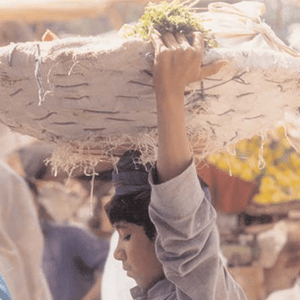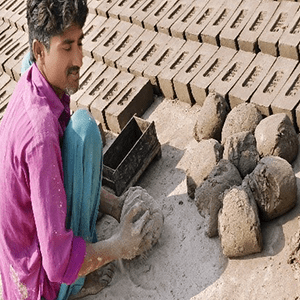Bonded Labor


Bonded labor, or debt bondage, is a form of modern slavery where individuals are forced to work to repay loans under exploitative and oppressive conditions. What begins as a desperate attempt to survive, borrowing money for essentials like food, healthcare, or shelter, often turns into a life sentence of unpaid labor.
Workers trapped in this cycle face inhumane conditions, long hours, and insubstantial wages, often insufficient to clear their debts.
Over time, these debts are passed down to their children, creating a generational cycle of slavery.
The debtor may end up entering or is assumed to have entered, into an agreement with the creditor under the condition in return for an advance (referred to as peshgi in Urdu) received by the debtor or any member of his family, whether documented or not, and the interest on such advance.
Under this system of bonded labor, the worker may be required to provide labor or services, either by themselves or through a family member, for the benefit of the creditor for a specified or unspecified period, often without any wage or with nominal pay; the worker is told that the pay is being adjusted against his debt.
The worker loses his freedom to seek employment or pursue other means of livelihood for a specified or unspecified period; and loses the right to move freely or to manage or sell his property or the products of his labor or that of his dependents.
The system also includes forced or partially forced labor when a surety for the debtor is required to perform the work if the debtor is unable to repay the debt.
Vulnerable populations are usually concentrated in regions with high poverty rates, weak enforcement of labor laws, and discriminatory practices. In Pakistan, industries like agriculture, brick-making, and domestic work are infamous for exploiting bonded labor. Despite laws eradicating bonded labor, millions remain trapped in this exploitative system.
Significant portions of the workforce in Pakistan are engaged in industries where debt bondage is widespread. Pakistan ranks 18th globally and 4th within Asia and the Pacific, according to the Global Slavery Index’s Prevalence Ranking; it says there are 2.3 million bonded laborers in the country.
Pakistan’s brick kiln industry employs millions, with entire families working to produce bricks. Usually, laborers are paid on a piece rate basis, (mostly per 1,000 bricks), but the wages are so low that they barely cover basic living expenses, let alone repay debts. The peshgi system, where advances are given in exchange for labor, ties families into cycles of exploitation. Dangerous working conditions and environmental hazards exacerbate their plight.


The agricultural sector, vital to Pakistan’s economy, is another hub of bonded labor. Landless farmers and sharecroppers are trapped in exploitative debt arrangements with feudal landlords, especially in provinces like Sindh and Punjab. Families live and work under the complete control of landlords, facing restricted mobility and enduring generational cycles of poverty.
The persistence of bonded labor in Pakistan is driven by a combination of structural and societal factors. The primary reason that compels laborers into bondage is poverty. It is deeply rooted in systemic issues that sustain exploitation.
Illiteracy prevents many from understanding loan terms or their legal rights, leaving them vulnerable to manipulation.
Caste and gender discrimination puts marginalized groups, including lower castes and religious minorities, particularly at risk.
In rural areas, feudal systems sustain inequality, keeping laborers dependent on landlords.
Efforts to end bonded labor face challenges like weak law enforcement, with under-resourced vigilance committees unable to take effective action.
Corruption and impunity allow landlords and kiln owners to avoid punishment.
The lack of rehabilitation programs leaves freed laborers without skills or opportunities, forcing them back into bondage.
In some areas, social acceptance of bonded labor normalizes this exploitation, making it even harder to eradicate.
The bonded labor phenomenon severely impacts families, particularly in terms of health, education, and social inclusion. The poor working conditions in which individuals are trapped often result in chronic illnesses and injuries, affecting their overall well-being and quality of life.
Children, who are often forced to work under bonded labor, are deprived of education, which limits their future opportunities and results in perpetuating the cycle of poverty within the family.
The bonded laborers are frequently marginalized and denied basic human rights, leading to social exclusion and further isolation from society. These compounded effects create long-term challenges for families caught in this cycle.
The International Labor Organization (ILO) has played an important role in the eradication of bonded labor. It passed the Forced Labor Convention (No 29) in 1930. Article 1 of the Convention calls its signatories to ‘suppress the use of forced labor in all its forms in the shortest period possible’.
The definition of forced labor was further clarified by the ILO by incorporating debt bondage and serfdom in the preamble to the Abolition of Forced Labor Convention (No 105).
Pakistan has signed and ratified both these Conventions and is consequently obligated under international law to take effective measures to eradicate bonded labor and uphold fundamental principles of human rights and labor standards.
Article 11(1) of Pakistan’s Constitution prohibits slavery and forced labor. Article 11(2) says that ‘all forms of forced labor and traffic in human beings are prohibited.’
The Bonded Labor System (Abolition) Act 1992 is a federal law that forbids the practice of bonded labor in its entirety. Section 6(3) terminates bonded laborers’ past debts. Section 15 calls upon the Government to establish Vigilance Committees at the district level to implement the law.
After the Eighteenth Amendment to the Constitution, the provinces enacted their laws about bonded labor. The Sindh Bonded Labor System (Abolition) Act 2015; the Punjab Bonded Labor System (Abolition) (Amendment) Act 2012; the KP Bonded Labor System (Abolition) Act 2015 and the Gilgit-Baltistan Bonded/ Forced Labor System (Abolition) Act 2020 were introduced.
Despite the laws, the condition of bonded laborers has not improved.
Bonded labor is a grave violation of human rights and a significant barrier to social and economic progress. Despite the ratification of international conventions and the existence of laws, bonded labor remains a persistent issue in Pakistan. This is largely due to the ineffective enforcement of the laws, which enables perpetrators to act with little consequence.
The gap between legal frameworks and their enforcement highlights the need for a more comprehensive approach to combat bonded labor. Addressing this challenge requires not only stronger law enforcement but also collaborative efforts with NGOs and civil society to address the root causes and enhance the effectiveness of anti-bonded labor initiatives.

